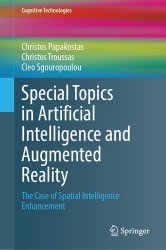 Название: Special Topics in Artificial Intelligence and Augmented Reality: The Case of Spatial Intelligence Enhancement
Название: Special Topics in Artificial Intelligence and Augmented Reality: The Case of Spatial Intelligence EnhancementАвтор: Christos Papakostas, Christos Troussas, Cleo Sgouropoulou
Издательство: Springer
Год: 2024
Страниц: 183
Язык: английский
Формат: pdf (true), epub
Размер: 18.9 MB
This monograph explores the synergy of Artificial Intelligence (AI), Augmented Reality (AR) and cognitive processes to enhance spatial abilities — an integral aspect of cognitive development. The ability to comprehend and manipulate spatial information is not only fundamental to our understanding of the physical world but also plays a pivotal role in numerous academic and professional fields. Recognizing the profound impact of spatial ability on scientific disciplines and educational achievement, this monograph takes on the challenge of enhancing spatial skills among users.
In an ever-evolving world driven by technological advancements, the intersection of spatial intelligence, augmented reality, and fuzzy logic user modeling has emerged as a captivating frontier of research and innovation. These three interconnected realms are not only at the forefront of technological development but also have the potential to reshape and enhance a multitude of domains, including education, artificial intelligence, and industry. However, while these concepts have made waves in academic circles and technology hubs, their integration into education remains relatively uncharted territory.
This book sets out to bridge this gap and provide an insightful perspective on the transformative power of spatial intelligence, augmented reality, and fuzzy logic user modeling in the realm of education. In our pursuit of this endeavor, we propose an innovative approach that combines adaptive hypermedia with mobile training applications. This groundbreaking method seeks to revolutionize the delivery of educational content by tailoring it to the specific needs and preferences of each learner.
The use of augmented reality in this approach is a cornerstone of our endeavor, offering a dynamic and interactive learning environment. By superimposing digital content onto the physical world, learners can engage with educational materials in a manner that is not only immersive but also profoundly tangible. This approach not only encourages active participation but also stimulates creativity and deepens understanding through visualizations, simulations, and real-time feedback.
What truly sets this approach apart is its incorporation of spatial intelligence training within the augmented reality experience. This facet enhances learners’ ability to perceive and comprehend spatial relationships, nurturing skills such as spatial visualization, mental rotation, and spatial reasoning, which hold significant value across various academic disciplines and real-world applications.
Скачать Special Topics in Artificial Intelligence and Augmented Reality: The Case of Spatial Intelligence Enhancement